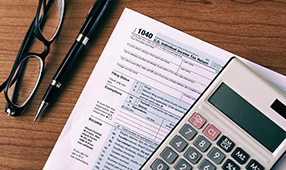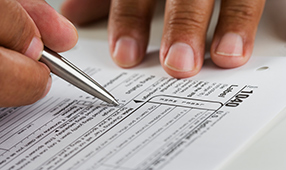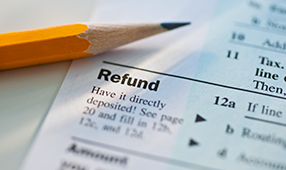Around Tax Day, many Americans receive an unexpected tax bill that can be a significant financial burden. Understanding the scenarios that lead to unanticipated tax liabilities and the available financial relief options can help you manage and mitigate the impact of such bills.
Common scenarios leading to unexpected tax bills
Five common scenarios that lead to unexpected tax bills are underpayment of estimated taxes, changes in tax laws, unreported income, incorrect withholding and life events.
Underpayment of estimated taxes
Taxpayers who do not have sufficient tax withheld from their paychecks throughout the year may face a higher-than-expected tax bill. This scenario is common among self-employed individuals, freelancers and those with significant nonwage income such as dividends, interest or capital gains. According to section 6654 of the Internal Revenue code, taxpayers must make estimated tax payments if they expect to owe at least $1,000 in tax after subtracting withholding and credits and if their withholding and credits are less than the smaller of 90% of the tax shown on the current year’s return or 100% of the tax shown on the previous year’s return.
Changes in tax laws
Legislative changes can alter tax liabilities, sometimes retroactively. For instance, the Tax Cuts and Jobs Act (TCJA) introduced new tax brackets, increased the standard deduction and eliminated personal exemptions, significantly impacting taxpayers' liabilities. Those who do not adjust their withholding or estimated tax payments to reflect these changes may find themselves owing more than expected.
Unreported income
Income that is not reported on tax returns, such as income from side jobs, freelance work or investment income, can lead to an unexpectedly high tax bill. The IRS receives copies of all 1099 forms and other income reports, and discrepancies between reported income and IRS records can trigger additional tax assessments.
Incorrect withholding
Incorrect withholding can occur if taxpayers do not update their Form W-4 to reflect changes in their financial situation, such as a new job, a raise or additional income sources. The IRS recommends using the Tax Withholding Estimator to ensure the correct amount of tax is withheld.
Life events
Significant life events such as marriage, divorce or the birth of a child can change a taxpayer’s filing status and number of dependents, affecting their tax liability. For example, getting married may push a couple into a higher tax bracket, while divorce may result in the loss of certain tax benefits.
Consequences of a large unexpected tax bill
In addition to monetary penalties, failure to anticipate your full tax liability or pay your taxes in a timely fashion can lead to other negative consequences, including a lower credit score and passport revocation.
Failure-to-pay penalty
If you do not pay your tax bill by the due date, the IRS will impose a failure-to-pay penalty. This penalty is generally 0.5% of the unpaid taxes for each month or part of a month that the tax remains unpaid, up to a maximum of 25% of the unpaid taxes.
Late-filing penalty
If you fail to file your tax return on time, the IRS will impose a late-filing penalty, which is generally 5% of the unpaid taxes for each month or part of a month that the return is late, up to a maximum of 25% of the unpaid taxes.
Interest accrual
Interest on unpaid taxes accrues from the due date of the return until the date of payment in full. The interest rate is determined quarterly and is the federal short-term rate plus 3%.
Lower credit score
Although the IRS does not directly report tax debts to credit bureaus, unpaid tax debts can lead to the filing of a notice of federal tax lien. This lien can be reported by credit bureaus and negatively impact your credit score.
Levy and seizure
If your tax debt remains unpaid, the IRS may levy (seize) your property, including bank accounts, wages and other assets.
Passport revocation
The Department of State may revoke or deny the issuance or renewal of your passport if you have a seriously delinquent tax debt.
How to pay a big tax bill
Once your tax return alerts you that you owe a significant sum, you'll need to come up with a payment plan. If you don't have enough money on hand to pay up front, some options are available to help you manage your tax liability.
If you’re facing hardship in paying taxes owed, seek out a qualified tax professional to help you make the best decisions for your individual case. You can also learn more about tax payment options on the IRS website.
Paying in full
The most straightforward way to handle an unexpected tax bill is to pay it in full by the due date. Doing so allows you to avoid paying additional interest and penalties. Taxpayers can use IRS Direct Pay or the Electronic Federal Tax Payment System (EFTPS) to make secure and timely payments.
Payment plans
If paying in full is not feasible, taxpayers can apply for a payment plan. The IRS offers short-term payment plans (up to 120 days) and long-term installment agreements (up to 72 months). Taxpayers can apply online, by phone or by submitting Form 9465, Installment Agreement Request.
Borrowing to pay off your tax debt
If you need more time than 180 days to pay your taxes, you may want to consider a bank loan—possibly through home equity—or even use your credit card. To reduce the interest burden of the latter, you could transfer what you owe into a new card with a favorable introductory rate.
While going into debt to pay your tax debt may not seem like a great option, the interest rate and fees charged by a bank or credit card issuer may be lower than the interest and penalties assessed by the IRS.
Offers in compromise
An offer in compromise (OIC) allows taxpayers to settle their tax debt for less than the full amount owed if they can demonstrate that paying the full amount will cause financial hardship. To apply for an OIC, taxpayers must submit Form 656, Offer in Compromise and Form 433-A (OIC), Collection Information Statement for Wage Earners and Self-Employed Individuals.
Temporary collection delays
Taxpayers experiencing significant financial hardship may request a temporary delay in collection activities. The IRS may temporarily delay collection until the taxpayer’s financial situation improves.
Follow these steps to request a temporary collection delay:
1. Contact the IRS promptly. Reach out by visiting IRS.gov or by calling the phone number listed on the notice (typically 1‑800‑829‑1040 for individual taxpayers or 1‑800‑829‑4933 for businesses) to speak with an agent about your hardship.
2. Submit a written request and financial disclosure. Your written request should explain that due to significant financial hardship, you are currently unable to pay your full tax liability and need a temporary delay in IRS collection actions.
In many cases, the IRS will require the taxpayer to complete a Collection Information Statement—often with forms such as Form 433‑A (for individuals) [PDF] or Form 433-F (for certain businesses and other taxpayers) [PDF]—to provide details of income, monthly expenses, assets and liabilities. Supporting documentation (such as bank statements, pay stubs, rent or mortgage receipts and other proof of expenses and income) should accompany the financial disclosure so that the IRS can verify the hardship.
Options for low-income taxpayers
Low-income taxpayers may qualify for assistance through the Low-Income Taxpayer Clinic (LITC) program, which provides representation in disputes with the IRS and helps with tax issues such as audits, appeals and collection matters. Additionally, the IRS offers the First Time Abate (FTA) administrative waiver for taxpayers who have a clean compliance history.
How to avoid a big surprise tax bill next year
You can take several steps to avoid an unpleasant tax bill next year.
Review and update form W-4
Employees should periodically review and update their Form W-4, Employee’s Withholding Certificate [PDF], especially after major life events such as marriage, divorce, a significant change in income or the birth or adoption of a child. The IRS recommends checking your withholding at the beginning of the year and whenever the tax laws or your personal circumstances change.
Be careful about withdrawing from your 403(b) and other retirement plans
Because 403(b) plans and many other retirement accounts are funded with pre-tax dollars, all the money you pull out to pay your taxes will probably be subject to income tax, plus a 10% penalty in most cases. Find a better alternative.
Use the IRS Tax Withholding Estimator
This online tool helps employees determine whether they need to give their employer a new Form W-4. The estimator takes into account various factors—including filing status, dependents and other sources of income—to provide a more accurate withholding amount.
Make quarterly estimated tax payments
If you have income that is not subject to withholding (such as self-employment income, rental income, dividends or capital gains), you may need to make quarterly estimated tax payments. These payments help spread your tax liability throughout the year and prevent you from receiving a large and unexpected bill at tax time.
Monitor income fluctuations
Regularly review your income, especially if you receive bonuses, commissions or other variable income. Adjust your withholding or estimated tax payments accordingly to reflect these changes.
Account for multiple jobs
If you or your spouse have more than one job, use the Multiple Jobs Worksheet [PDF] on Form W-4 or the IRS Tax Withholding Estimator to ensure accurate withholding across all jobs.
Tools and Resources
This estimator considers various factors such as filing status, dependents, deductions and other sources of income to provide a detailed withholding recommendation. It helps ensure that the correct amount of tax is withheld from your paycheck.
Staying updated on changes in tax law
IRS publications are useful for staying up to date on changes in tax law. For example, IRS Publication 505, Tax Withholding and Estimated Tax provides detailed guidance on withholding and estimated tax payments.
Conclusion
Unexpected tax bills can arise for various reasons, including underpayment of estimated taxes, changes in tax laws, unreported income, incorrect withholding and significant life events. By understanding these reasons and using available tools, you can effectively manage your tax obligations and avoid a surprise tax bill next year. You can choose from several options to mitigate the impact of an unexpected tax bill: paying in full, setting up a payment plan, applying for an offer in compromise, requesting a temporary collection delay and seeking assistance through low-income taxpayer programs.










